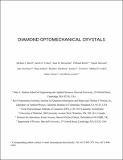| dc.contributor.author | Burek, Michael John | |
| dc.contributor.author | Cohen, Justin | |
| dc.contributor.author | Meenehan, Seán | |
| dc.contributor.author | Ruelle, Thibaud | |
| dc.contributor.author | Meesala, Srujan | |
| dc.contributor.author | Rochman, Jake | |
| dc.contributor.author | Atikian, Haig Avedis | |
| dc.contributor.author | Markham, Matthew | |
| dc.contributor.author | Twitchen, Daniel | |
| dc.contributor.author | Lukin, Mikhail D. | |
| dc.contributor.author | Painter, Oskar | |
| dc.contributor.author | Loncar, Marko | |
| dc.date.accessioned | 2017-08-07T17:59:23Z | |
| dc.date.issued | 2016 | |
| dc.identifier.citation | Burek, Michael J., Justin D. Cohen, Seán M. Meenehan, Nayera El-Sawah, Cleaven Chia, Thibaud Ruelle, Srujan Meesala, et al. 2016. “Diamond Optomechanical Crystals.” Optica 3 (12) (November 18): 1404. doi:10.1364/optica.3.001404. | en_US |
| dc.identifier.issn | 2334-2536 | en_US |
| dc.identifier.uri | http://nrs.harvard.edu/urn-3:HUL.InstRepos:33719354 | |
| dc.description.abstract | Cavity-optomechanical systems realized in single-crystal diamond are poised to benefit from its extraordinary material properties, including low mechanical dissipation and wide optical transparency window. Diamond is also rich in optically active defects, such as the nitrogen-vacancy (NV) center, which behave as atom-like systems in the solid state. Predictions and observations of coherent coupling of the NV electronic spin to phonons via lattice strain has motivated the development of diamond nanomechanical devices aimed at realization of hybrid quantum systems, in which phonons provide an interface with diamond spins. In this work, we demonstrate a device platform to enable such applications: diamond optomechanical crystals (OMCs), where the co-localization of ~ 200 THz photons and ~ 6 GHz phonons in a quasi-periodic diamond nanostructure leads to coupling of an optical cavity field to a mechanical mode via the radiation pressure of light. In contrast to other material systems, diamond OMCs operating in the resolved sideband regime possess large intracavity photon capacity (> 105) and sufficient optomechanical coupling rate to exceed a cooperativity of ~ 1 at room temperature and realize large amplitude optomechanical self-oscillations. Strain-mediated coupling of the high frequency (~ GHz) mechanical modes of these devices to the electronic and spin levels of diamond color centers has the potential to reach the strong spin-phonon coupling regime, and enable a coherent interface with diamond qubits for applications in quantum-nonlinear optomechanics. | en_US |
| dc.description.sponsorship | Physics | en_US |
| dc.language.iso | en_US | en_US |
| dc.publisher | The Optical Society | en_US |
| dc.relation.isversionof | doi:10.1364/OPTICA.3.001404 | en_US |
| dc.relation.hasversion | http://arxiv.org/abs/1512.04166 | en_US |
| dash.license | OAP | |
| dc.title | Diamond optomechanical crystals | en_US |
| dc.type | Journal Article | en_US |
| dc.description.version | Accepted Manuscript | en_US |
| dc.relation.journal | Optica | en_US |
| dash.depositing.author | Lukin, Mikhail D. | |
| dc.date.available | 2017-08-07T17:59:23Z | |
| dc.identifier.doi | 10.1364/OPTICA.3.001404 | * |
| dash.authorsordered | false | |
| dash.contributor.affiliated | Burek, Michael | |
| dash.contributor.affiliated | Atikian, Haig | |
| dash.contributor.affiliated | Loncar, Marko | |
| dash.contributor.affiliated | Lukin, Mikhail | |


